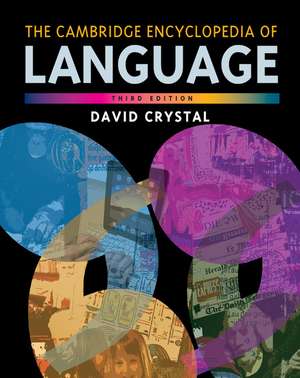The Cambridge Encyclopedia of Language
Autor David Crystalen Limba Engleză Paperback – 2 iun 2010
Preț: 388.52 lei
Nou
Puncte Express: 583
Preț estimativ în valută:
74.35€ • 77.34$ • 61.38£
74.35€ • 77.34$ • 61.38£
Carte disponibilă
Livrare economică 24 martie-07 aprilie
Livrare express 08-14 martie pentru 87.96 lei
Preluare comenzi: 021 569.72.76
Specificații
ISBN-13: 9780521736503
ISBN-10: 0521736501
Pagini: 524
Ilustrații: 200 b/w illus. 20 maps 100 tables
Dimensiuni: 219 x 276 x 36 mm
Greutate: 1.66 kg
Ediția:Revizuită
Editura: Cambridge University Press
Colecția Cambridge University Press
Locul publicării:Cambridge, United Kingdom
ISBN-10: 0521736501
Pagini: 524
Ilustrații: 200 b/w illus. 20 maps 100 tables
Dimensiuni: 219 x 276 x 36 mm
Greutate: 1.66 kg
Ediția:Revizuită
Editura: Cambridge University Press
Colecția Cambridge University Press
Locul publicării:Cambridge, United Kingdom
Cuprins
Preface to 1st edition; Preface to 2nd edition; Preface to 3rd edition; Part I. Popular Ideas About Language: 1. The prescriptive tradition; 2. The equality of languages; 3. The magic of language; 4. The functions of language; 5. Language and thought; Part II. Language and Identity: 6. Physical identity; 7. Psychological identity; 8. Geographical identity; 9. Ethnic and national identity; 10. Social identity; 11 Contextual identity; 12. Stylistic identity and literature; Part III. The Structure of Language: 13. Linguistic levels; 14. Typology and universals; 15. The statistical structure of language; 16. Grammar; 17. Semantics; 18. Dictionaries; 19. Names; 20. Discourse and text; 21. Pragmatics; Part IV. The Medium of Language: Speaking and Listening: 22. The anatomy and physiology of speech; 23. The acoustics of speech; 24. The instrumental analysis of speech; 25. Speech reception; 26. Speech interaction with machines; 27. The sounds of speech; 28. The linguistic use of sound; 29. Suprasegmentals; 30. Sound symbolism; Part V. The Medium of Language: Writing and Reading: 31. Written and spoken language; 32. Graphic expression; 33. Graphology; 34. The process of reading and writing; Part VI. The Medium of Language: Signing and Seeing: 35. Sign language; 36. Sign language structure; 37. Types of sign language; Part VII. Child Language Acquisition: 38. Investigating children's language; 39. The first year; 40. Phonological development; 41. Grammatical development; 42. Semantic development; 43. Pragmatic development; 44. Language development in school; Part VIII. Language, Brain, and Disability: 45. Language and the brain; 46. Language disability; Part IX. The Languages of the World: 47. How many languages?; 48. How many speakers?; 49. The origins of language; 50. Families of language; 51. The Indo-European family; 52. Other families; 53. Language isolates; 54. Language change; 55. Pidgins and creoles; Part X. Language in the World: 56. The language barrier; 57. Translating and interpreting; 58. Artificial languages; 59. World languages; 60. Multilingualism; 61. Language planning; 62. Foreign language teaching and learning; 63. Language for special purposes; Part XI. Language and Communication: 64. Language and other communication systems; 65. Linguistics; Appendices: I. Glossary; II. Special symbols and abbreviations; III. Table of the world's languages; IV. Further reading; V. Index of languages, families, dialects, and scripts; VI. Index of authors and personalities; VII. Index of topics; Acknowledgements.
Recenzii
'… a celebration of language in all its oddity, beauty, fun, astonishing complexity and limitless variety.' London Review of Books
'The Cambridge Encyclopedia of Language is a masterpeice of comprehensiveness and clarity.' New Internationalist
'… an ingenious tour de force … stunningly diverse linguistic menu.' Robert Burchfield, The Times
'… magnificently demonstrates Professor Crystal's outstanding breadth of knowledge, incisiveness of judgment and superb skills at getting to the heart of highly complex issues in a clear and straightforward manner.' Randolph Quirk, FBA
'… David Crystal has a great facility for explaining language issues with plain good sense, wit and admirable brevity.' The Times Educational Supplement
'One of the world's foremost linguistic experts, Crystal has authored numerous tomes on the history and study of the English language, though this, with its full-colour illustrations and exhaustive index, is arguably the most comprehensive. A useful guide for anyone - from the interested layperson to the most widely read of academics.' The Independent
'The Cambridge Encyclopedia of Language is a masterpeice of comprehensiveness and clarity.' New Internationalist
'… an ingenious tour de force … stunningly diverse linguistic menu.' Robert Burchfield, The Times
'… magnificently demonstrates Professor Crystal's outstanding breadth of knowledge, incisiveness of judgment and superb skills at getting to the heart of highly complex issues in a clear and straightforward manner.' Randolph Quirk, FBA
'… David Crystal has a great facility for explaining language issues with plain good sense, wit and admirable brevity.' The Times Educational Supplement
'One of the world's foremost linguistic experts, Crystal has authored numerous tomes on the history and study of the English language, though this, with its full-colour illustrations and exhaustive index, is arguably the most comprehensive. A useful guide for anyone - from the interested layperson to the most widely read of academics.' The Independent
Descriere
This completely revised and expanded edition of Crystal's acclaimed book incorporates developments in the lively field of language study.
